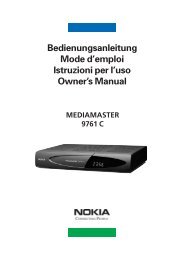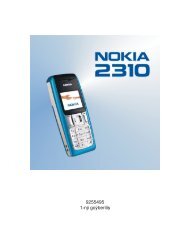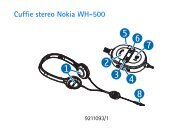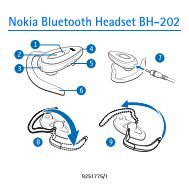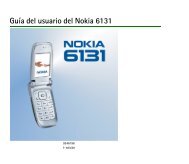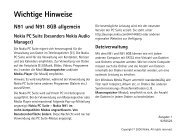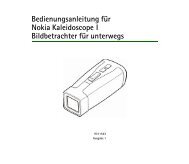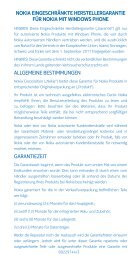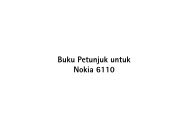Nokia E90 Communicator User Guide
Nokia E90 Communicator User Guide
Nokia E90 Communicator User Guide
Create successful ePaper yourself
Turn your PDF publications into a flip-book with our unique Google optimized e-Paper software.
C o n n e c t i v i t y<br />
passcode. When the device asks to make the connection automatic, select Yes. If you select No, connection requests from this<br />
device must be accepted separately every time.<br />
To end the remote SIM access connection from your device, select > Connectivity > Bluetooth > Remote SIM mode > Off.<br />
Infrared<br />
Do not point the infrared (IR) beam at anyone's eye or allow it to interfere with other IR devices. This device is a Class 1 laser<br />
product.<br />
Use infrared to connect two devices and transfer data between them. With infrared, you can transfer data such as business<br />
cards, calendar notes, and media files with a compatible device.<br />
Send and receive data<br />
1. Ensure that the infrared ports of the devices face each other. The positioning of the devices is more important than the angle<br />
or distance.<br />
2. Select > Connectivity > Infrared to switch on infrared on your device.<br />
3. Switch on infrared on the other device and wait a few seconds until the infrared connection is established.<br />
4. Locate the desired file in an application or File manager, and select Options > Send > Via infrared.<br />
If the data transfer is not started within 1 minute after the activation of the infrared port, the connection is cancelled and must<br />
be started again.<br />
All items received through infrared are placed in the Inbox folder in Messaging.<br />
Positioning the devices away from each other breaks the connection, but the infrared light beam remains active on your device<br />
until it deactivates.<br />
Internet access points<br />
An access point is where your device connects to a network. To use e-mail and multimedia services or to connect to the internet<br />
and browse web pages, you must first define the internet access point for these services. You may need to set up several internet<br />
access points, depending on the sites you want to access. For example, browsing the web may require one access point, and<br />
accessing your company intranet may require another. To connect to the internet over GPRS, your device may have predefined,<br />
default internet access point settings.<br />
When you switch on your device for the first time, the access points may be configured automatically based on the service<br />
provider information in your SIM card. You can also receive the access point settings in a message from your service provider.<br />
This might reduce the number of settings you need to enter yourself.<br />
The available options may vary. Some or all access points may be preset for your device by your service provider. You may not<br />
be able to add, edit, or delete access points. Contact your service provider and e-mail service provider for more information on<br />
access points and their settings.<br />
Set up an internet access point for data calls<br />
1. Select > Tools > Settings > Connection > Access points.<br />
2. Select Options > New access pointto create a new access point, or select an existing access point from the list and then<br />
Options > Duplicate access point to use the access point as a basis for the new one.<br />
3. Define the following settings.<br />
• Connection name — Enter a descriptive name for the connection.<br />
• Data bearer — Select Data call or High speed (GSM).<br />
• Dial-up number — Enter the modem telephone number of the access point. Use + before international numbers.<br />
• <strong>User</strong> name — Enter your user name if required by the service provider. <strong>User</strong> names are often case-sensitive and provided<br />
by your service provider.<br />
• Prompt password — Select Yes to enter your password each time you log into a server or No to save the password in your<br />
device memory and automate the login.<br />
• Password — Enter your password if required by the service provider. The password is often case-sensitive and provided<br />
by the service provider.<br />
• Authentication — Select Secure to send your password always encrypted or Normal to send your password encrypted<br />
when possible.<br />
• Homepage — Enter the web address of the page you want to display as the home page when you use this access point.<br />
• Data call type — Select Analogue, ISDN v.110, or ISDN v.120.<br />
• Maximum data speed — Select the limit to apply to the transfer speed. If you select Automatic, the data transfer rate is<br />
determined by the network and may be affected by network traffic. Some service providers may charge more for higher<br />
data rates.<br />
© 2007 <strong>Nokia</strong>. All rights reserved. 47



